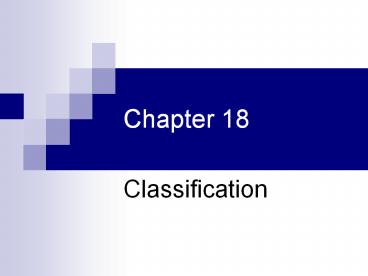Classification PowerPoint PPT Presentation
1 / 19
Title: Classification
1
Chapter 18
- Classification
2
Classification
- Taxonomy- the field of Biology that identifies
and classifies organisms. - Binomial Nomenclature two-word naming system
used to identify organisms.
3
- The first part of the name is the genus to which
the organism belongs. A genus is a group of
closely related species. The genus name is
capitalized. - The second part of the name is unique to each
species within the genus. This part of the name
often describes an important trait or where the
organism lives. The species name is lowercased.
4
- All organisms have 2 names
- 1. Scientific Name -consists of a genus name
and a - species name. Genus is always written 1st and
IS - CAPITALIZED. Species is always written 2nd and
is NOT - capitalized.
- Both names are printed and underlined or in
Italics - Ex Homo sapiens or Homo sapiens
- Ex H. sapiens or H. sapiens
- 2. Common name- name that is used more
- regularly.
- Ex Mountain lion, puma, cougar, panther all
- common names for the same animal depending on
- the region.
5
Carolus Linnaeus
- Developed the classification system in mid
1700s. A hierarchical format from the very
broad groups (least related or the least amount
of similarities) to very specific (more precise)
members. - Kingdom
- Phylum
- Class
- Order
- Family
- Genus
- Species
6
The kingdom is the largest and most inclusive of
Linnaeus's taxonomic categories.
7
Several different classes make up a phylum.
8
The next larger category, the class, is composed
of similar orders.
9
An order is a broad category composed of similar
families.
10
Genera that share many characteristics are
grouped in a larger category, the family.
11
Each level is called a taxon, or taxonomic
category.Species and genus are the two smallest
categories
12
- The Three-Domain System
- Molecular analyses have given rise to a new
taxonomic category that is now recognized by many
scientists. - The domain is a more inclusive category than any
otherlarger than a kingdom.
13
Six KingdomsRecently, biologists recognized that
Monera were composed of two distinct groups
Eubacteria and Archaebacteria.
- The six-kingdom system of classification
includes - Eubacteria
- Archaebacteria
- Protista
- Fungi
- Plantae
- Animalia
14
Modern Evolutionary Classification
- Phylogeny- evolutionary relationships among
organisms - Biologists group organisms into categories that
represent lines of evolutionary descent, or
phylogeny, not just physical similarities. - Organisms that share the same genus are more
closely related than organisms that only share
the same family.
15
Derived Characters
- Characteristics that appear in recent parts of a
lineage, but not in its older members - They can be used to construct a Cladogram.
- A cladogram is a diagram that shows the
evolutionary relationships among a group of
organisms.
16
Cladogram
See Page 460
17
Dichotomous Keys
- A tool used for identifying organisms by using
specific observable traits of the organism.
18
The first step in the key will be organized the
following way 1. a. wings covered by an
exoskeleton b. wings not covered by an
exoskeleton Next, the statements need to lead
the observer to the next step to narrow the
identification further 1. a. wings covered by
an exoskeleton go to step 2 b. wings not
covered by an exoskeleton .go to step 3 Step
2 needs to consist of a pair of statements that
will allow for the identification of the ladybug
and the grasshopper 2. a. body has a round shape
.ladybug b. body has an elongated shape
.grasshopper
19
Classification of Living Things Classification of Living Things Classification of Living Things Classification of Living Things Classification of Living Things Classification of Living Things Classification of Living Things
DOMAIN Bacteria Archaea Eukarya Eukarya Eukarya Eukarya
KINGDOM Eubacteria Archaebacteria Protista Fungi Plantae Animalia
CELL TYPE Prokaryote Prokaryote Eukaryote Eukaryote Eukaryote Eukaryote
CELL STRUCTURES Cell walls with peptidoglycan Cell walls without peptidoglycan Cell walls of cellulose in some some have chloroplasts Cell walls of chitin Cell walls of cellulose chloroplasts No cell walls or chloroplasts
NUMBER OF CELLS Unicellular Unicellular Most unicellular some colonial some multicellular Most multicellular some unicellular Multicellular Multicellular
MODE OF NUTRITION Autotroph or heterotroph Autotroph or heterotroph Autotroph or heterotroph Heterotroph Autotroph Heterotroph
EXAMPLES Streptococcus, Escherichia coli Methanogens, halophiles Amoeba, Paramecium, slime molds, giant kelp Mushrooms, yeasts Mosses, ferns, flowering plants Sponges, worms, insects, fishes, mammals

